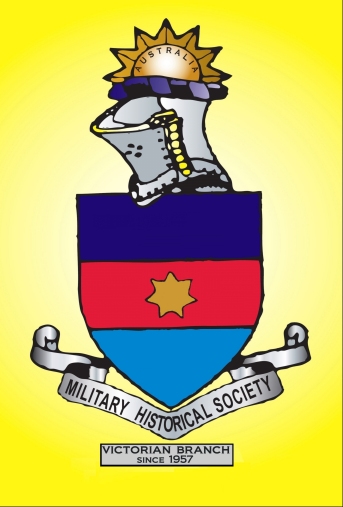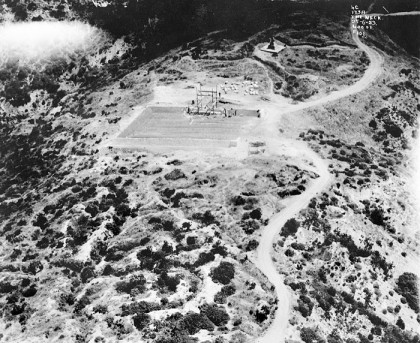Presented to the MHSA Victoria Branch 28 May 2009 by Jeff Pickerd
The Charge at the Nek, Gallipoli - 7th August 1915
The Nek 1923. The Nek cemetery (centre), then under construction, was the no-man's land between the Australian lines on Russell's Top and the Turk lines. It is there that the charge took place. The Turkish monument (at rear) is roughly the third line of Turkish trenches.
The Charge at the Nek, 4.30 am, 7th August 1915 is an epic tale of Gallipoli that will be well known by all; it is one of the iconic events from the campaign that probably all of us have grown up knowing about. It falls within the four most known about events that have become legendry from the Gallipoli campaign, and are now synonymous to the meaning of Anzac; The Landing, 25th April, Simpson and his Donkey, Lone Pine and then, the Nek.
Much has been written of the charge, and it is from Australian war correspondent Charles Edwin Woodrow Bean that that came about. His first report of the charge was published in the Melbourne Argus, September 28, 1915 and the tragedy of that morning of the 7th August was revealed to the Victorian public and Australia at large. His second article in the Argus, on 8th October, relayed a detailed description of how the charge unfolded and the location and description of where it took place. Bean's article gave the purpose of the attack, the plan, the units, officers and numbers of men, the artillery bombardment, the actions of each subsequent four lines of the charge, and described its heroic, but tragic failure.
Bean tells of how the 3rd Light Horse Brigade had gone to Gallipoli as dismounted infantry and being allotted the extreme northern section of the Anzac front line at Walker's Ridge and Russell's Top. On 7th August the 8th and 10th L.H. Regiments of the Brigade charged the strongly defended Turkish trenches at the Nek. Each of the successive four lines were mowed down by intensive rifle and machine gun fire and the effects of bombs and artillery shrapnel - Bean had never previously experienced the intensity and noise of that battle.
From his remarkable Official History of Australian in the War of 1914-18, Volume 2,
(The Story of Anzac, Chapter 23, 'The Feints of August 7th'), Bean laid down the historical account of what took place that morning. It would become the benchmark for over the next 90 years for all following publications that covered the charge at the Nek. Since that seminal work, published in 1924, there has only been one other work specifically devoted to the charge, namely The Nek, by Peter Burness and published in 1995. Here for the first time was a work that gave a greater insight and indepth coverage to all aspects of the charge including the major players, the orders and personal accounts.
From Burness all the way back to Bean, and including all other published works by such authors as Bill Gammage, Jonathon King, Harvey Broardbent, Les Carlyon, Cameron Simpson, etc., there are extracts of accounts from men of the 8th and 10th L.H. Regiments giving their personal experience of the charge. They tell of what each man experienced during the charge and what happened to the officers and men around them. However, where exactly were these eye witness accounts emanating from on Russell's Top? John Hamilton's Goodbye Cobber, God Bless You helped to resolve this question, not just with further accounts by the men themselves, but also with the publishing of three important, but previously hidden, documents:
- The Forming Up Plan for the Charge at the Nek
- Lieutenant-Colonel White's Anzac Trench Diagram No. 1
- Lieutenant-Colonel Brazier's Sketch of Russell's Top, completed for C.E.W. Bean in 1929.
Another question which has intrigued historians was "Who was to blame?" The Brigade Major of the 3rd Light Horse Brigade, Lieutenant-Colonel John Macquarie Antill, known as the 'Bull' or 'Bullant', has been a favourite target of some of the men in the charge as well as C.E.W. Bean himself whose dislike and antagonism towards Antill was clearly evident in his history (Bean also had little faith in the recollections of Colonel Frederick Hughes, Commanding Officer of the 3rd L.H. Brigade). Antill was not universally liked by the commanders of the 3rd L.H. Brigade's three regiments, namely Lieutenant-Colonels White of the 8th, Mielle of the 9th and Brazier of the 10th L.H. let alone many of the other ranks of those regiments. Even when the attack was a deadly fiasco, Antill told the men to 'go on' into certain death at the Nek.
So should Antill be held entirely responsible for the eventual outcome of the disastrous charge? Not entirely. There were key figures higher up the chain of command that were responsible for the planning and final orders for all the various operations of the Gallipoli August offensive. Colonel Hughes also contributed a part when, by not remaining at the headquarters dug-out during the charge, he could not be found when his orders were needed to call off the charge.
The ongoing process of digitizing all of the Unit War Diaries held by the Australian War Memorial and especially the Formation Headquarters series which include the 3rd L.H. Brigade war diaries, have given new access to the planning process for the Charge. From these the actions of Antill to order the continuation of the charge are seen. The original plans for the August offensive, which included the diversionary attack at Lone Pine, were developed by Lieutenant-General William Birdwood, (Commander of the Australian and New Zealand Army Corps (Anzac)) and his Staff Officer, Brigadier General Andrew Skeen, in May 1915. Under this plan the main attack would be directed on the heights to the north of Anzac, at Chunnuk Bair and Hill 971. The Commander-in-Chief of the Mediterranean Expeditionary Force General Sir Ian Hamilton approved of this plan, but in mid June expanded the operation for the breaking out from Anzac with a new landing by British Territorials at Suvla Bay.
From the beginning of July plans for the new offensive were well under way, although being carried out in total secrecy, and only to some extent privvy to the most senior Divisional commanders. By the beginning of August, General Divisional Orders for planned operations of the new offensive from Skeen and Lieutenant-Colonel W. G. Braithwaite (Staff Officer, Anzac Division) begin to flow to various Brigade commanders. These orders give specific instructions as to how the forthcoming offensive will be carried out. Antill, at 3rd Brigade HQ, developed Operational Order No.1 dated 5th August - the orders for the Brigade's part in the attack. The higher level directives which formed the basis for Antill's orders were very precise, detailing the role each line of the charge will undertake, the objectives to be seized, and equipment to be carried. They left Antill little option but to follow them to the letter. He had no authority to call off the attack when it became clear it was a failure, especially in the absence of the Brigade Commander.
The speaker:
Jeff Pickerd is an amateur historian who has devoted over seven years to the study of the 8th Light Horse Regiment, with a particular emphasis to its role during the Gallipoli campaign. His extensive research and expertise has been acknowledged in a number of publications dealing with the 8th L.H. Regiment, and other aspects of the Gallipoli campaign. Jeff is a member of the MHSA (Vic), the FFFAIF, and is a regular contributor to the discussion forums of the Australian Light Horse Association and the Great War Forum (U.K.). Jeff is a Volunteer Guide at the Shrine of Remembrance, Melbourne.


